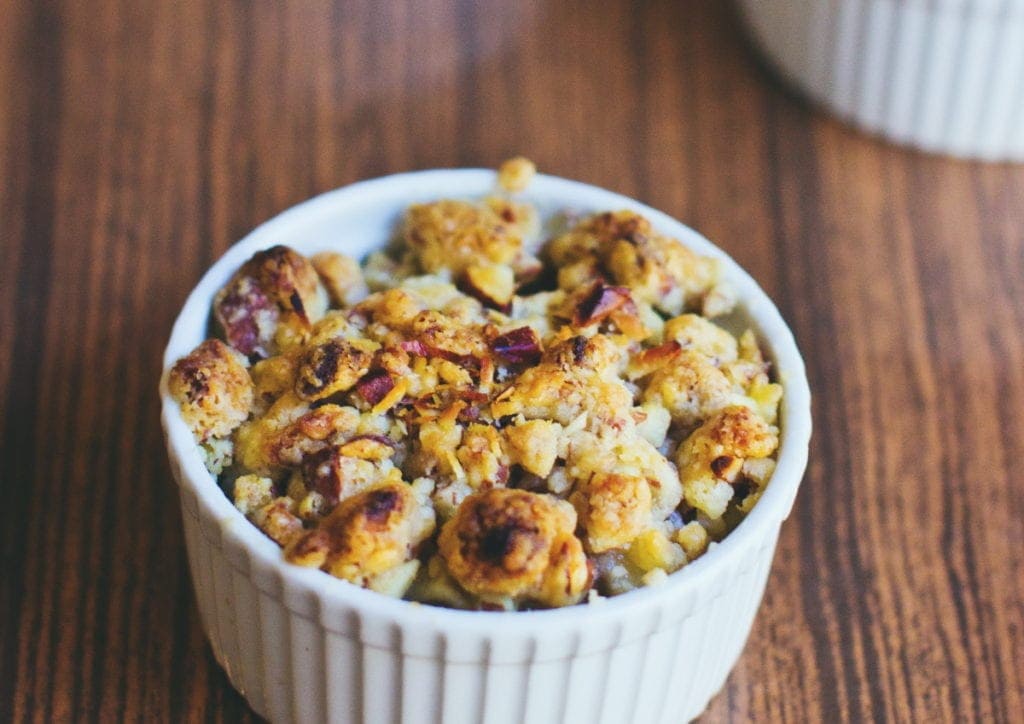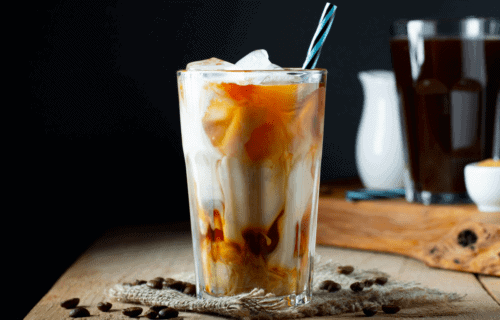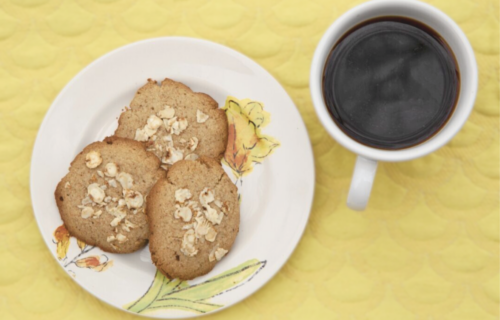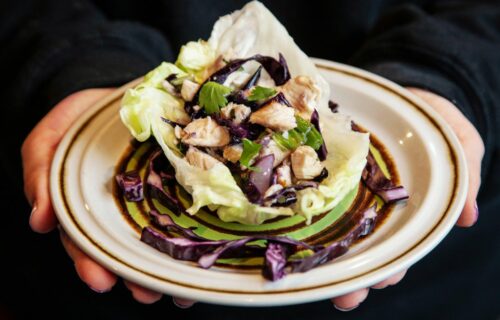
Low Histamine Apple Crumble Recipe (also lower oxalate, low lectin) And Sweetener Options – for Mast Cell Activation Syndrome or Histamine Intolerance
If you have Histamine Intolerance or Mast Cell Activation Syndrome, don’t give into sugar temptations! Sugar is well known to increase histamine levels and Mast Cell Activation Syndrome symptoms.
The Problems with Sugar and Mast Cell Activation Syndrome or Histamine Intolerance
Histamine plays a role in the development of Type 2 Diabetes. Mast Cell Activation is also involved in Insulin Resistance and Metabolic Syndrome.
Sugar consumption is also linked with increased asthma in children. Asthma is often associated with Histamine Intolerance and Mast Cell Activation Syndrome.
If you want to control your Mast Cell Activation Syndrome or Histamine Intolerance, it is important to control your blood sugar. So, you want to avoid using sugar in all forms:
- Agave
- Brown Rice Syrup
- Cane sugar (white, brown, and turbinado cane sugar)
- Coconut Sugar
- Corn Syrup and High Fructose Corn Syrup
- Date Sugar
- Dextrose
- Honey
- Maple Syrup
- Molasses
Of these sugars, coconut sugar is the lowest glycemic. This means it affects blood sugar the least. But coconut sugar will still cause your blood sugar to go up.
These are the kinds of Food Triggers I mention in my Mast Cell 360 – 7 Common Root Causes of Mast Cell Activation Syndrome. (These are the same root causes in Histamine Intolerance too!)
So, what should you do if you enjoy sweets and you have Mast Cell Activation Syndrome or Histamine Intolerance?
Sweetener Options when you have Mast Cell Activation Syndrome or Histamine Intolerance
First, let’s talk about what sweeteners you DON’T want to use. You definitely don’t want to use artificial sweeteners. These are:
- Acesulfame Potassium – Brands: Sunnett, Sweet One
- Aspartame – Brands: Nutrasweet, Equal
- Saccharin – Brands: Sweet ‘N Low, Sweet Twin, Sugar Twin
- Sucralose – Splenda
These are harmful chemicals. There is significant research that these artificial sweeteners cause health issues. These can increase Histamine Intolerance and Mast Cell Activation Syndrome.
Also be careful with Sugar Alcohols in “sugar free” foods. These can cause gut issues. Sugar alcohols include:
- Isomalt
- Lactitol
- Maltitol
- Mannitol
- Sorbitol
- Xylitol
So, what sweeteners CAN you use when you have Mast Cell Activation Syndrome or Histamine Intolerance?
The best sweeteners when you have Mast Cell Activation Syndrome or Histamine Intolerance are:
- Organic Stevia
- 100% Monk Fruit
You have to watch out, though! The majority of the time Monk Fruit has additives like the sugar alcohol erythritol. And Stevia is often packaged with Dextrose.
Here are the brands of 100% Stevia and Monk Fruit that I use that are additive-free:
Pure Monk Fruit Extract, Organic Better Stevia
(or Organic Better Stevia Alcohol Free)
Stevia can have a little bit of a bitter aftertaste. So, I mostly use it in herbal teas or I combine it with Monk Fruit. Monk Fruit has a slightly caramel flavor. I like it much better for desserts.
Both Stevia and Monk Fruit have a lot of health benefits if you have Mast Cell Activation Syndrome or Histamine Intolerance!
Stevia has shown to help lower blood sugar. Good news for Mast Cell Activation Syndrome or Histamine Intolerance!
And Monk Fruit (also called Lo Han Kuo) has been shown to help reduce Histamine from mast cell activation. It has also shown in research to have anti-inflammatory properties.
Since inflammation increases Mast Cell Activation and Histamine production – anything anti-inflammatory is usually a great thing for you!
You can see why Stevia and Monk Fruit are my favorite sweeteners. These are what I use in this Apple Crumble Dessert.
So, let’s get on to the recipe!
Low Histamine Apple Crumble Recipe (also lower oxalate, low lectin) for Mast Cell Activation Syndrome or Histamine Intolerance

This is one of my favorite desserts. It is satisfying and full of histamine lowering ingredients. Apples are a great source of quercetin – a well-known Mast Cell stabilizer.
And we’ve already discussed the great properties of Stevia and Monk Fruit.
Allspice, Clove, and Cinnamon are traditional in baked apple desserts. But these are all Histamine Liberators.
So, instead I use a little Cardamom – which has anti-inflammatory properties.
And here is my secret ingredient…
Camu Camu powder! This is a low histamine, low oxalate foods-based source of Vitamin C. It’s my favorite source of Vitamin C, actually. And it has a nice allspice flavor that works beautifully with apples. You want Organic and a reliable brand free of toxins. I use Navitas Camu Camu powder.
Pecans can be high in mold toxins. To reduce them, I recommend soaking pecans in salt water for 12 hours in the fridge. Then dry them until crispy in a food dehydrator or oven on lowest temperature.
One last tip – make SURE your apples are organic. Conventional apples are notoriously high in pesticide residues that can make Mast Cell Activation Syndrome or Histamine Intolerance worse.
So, let’s put all this together for this recipe:
Ingredients:
- 4 organic apples (any kind)
- 1/4 teaspoon Pure Monk Fruit Extract
- ½ teaspoon Navitas Organic Camu Camu powder, divided
- ½ teaspoon Organic Cardamom powder, divided
- ½ teaspoon Raw Organic Vanilla Powder, divided
- 2 Pinches of Redmond Real Salt
- ¼ cup grass fed ghee or Virgin Coconut Oil, softened
- 1/4 teaspoon Pure Monk Fruit Extract OR 10-20 drops Organic Better Stevia
- ½ cup of chopped, organic pecans (soaked and dried)
Directions
- Preheat oven to 325F.
- Use ghee or coconut oil to grease a 6×9” glass baking dish.
- Wash apples and slice into ¼” slices. The quercetin is mostly in the peel, so I leave the peel on.
- Mix together 1 pinch of salt and ¼ tsp each Monk Fruit Powder, Camu Camu powder, Cardamom powder, and Vanilla powder. Toss apples with this mixture.
- Arrange apples in bottom of the baking dish.
- Put ghee or coconut oil, chopped pecans, 1 pinch salt, Stevia or Monk Fruit, and ¼ tsp each Camu Camu powder, Cardamom powder, and Vanilla powder into a food processor.
- Pulse the nut crumble mixture until well combined and the ingredients start to stick together. Don’t over process.
- Layer the crumble mixture on top of the apples.
- Bake 20-30 minutes, until apples are soft and cooked through. Keep an eye on the topping to make sure it doesn’t burn. If topping starts to get too brown, lower temperature or cover the dish.
- This freezes well. Enjoy and freeze the leftovers!
Want to step this recipe up a notch? You can top it with Whipped Coconut Cream!
- 1 cup Let’s Do Organic Coconut Cream
- 1 Tablespoon Pure Monk Fruit Extract
- ½ teaspoon raw vanilla powder
- Scoop out 1 cup of coconut cream. Whip the coconut cream, monk fruit extract, and raw vanilla powder with a whisk.OR If you have coconut milk on hand, you can use that, too. Here’s how. Allow coconut milk to sit in the refrigerator all night, remove it from the fridge. Then open the package and scoop only the thickest cream from the top of the package.
- Top apple crumble with coconut cream.
- You can use the leftover coconut water or coconut cream for smoothies or other recipes. You can freeze it in an ice cube tray to make it easier to use.
More Low Histamine Dessert Recipes
- White Chocolate Cookie Dough – Low Lectin and Medium Oxalate
- Macadamia Nut Butter – Low FODMAP, Low Lectin, and Low Oxalate
- Low Histamine Blueberry Cassava Flour Muffins – Low Lectin and Low Oxalate
- 6 Layer Cranberry Trifle – Low Lectin and Low Oxalate
- Pecan Clusters – Low Lectin and Medium Oxalate
References about Relationships between Sugar Consumption, Type 2 Diabetes, and Metabolic Syndrome with Mast Cell Activation Syndrome and Histamine Intolerance
*Some links in this website are affiliate links, which means Mast Cell 360 may make a very small commission if you purchase through the link. It never costs you any more to purchase through the links, and we try to find the best deals we can. We only recommend products that we love and use personally or use in the Mast Cell 360 practice. Any commissions help support the newsletter, website, and ongoing research so Mast Cell 360 can continue to offer you free tips, recipes, and info. Thank you for your support!




I reacted badly to camu camu, are you sure it is low histamine? Not for me!
Hi Hilly,
Camu camu does work for most people with mast cell and histamine issues, but people with mast cell issues can react to anything. This means we all have to test everything for ourselves. Also, if your Histamine bucket is really overflowing, you may not tolerate anything dried until your Histamine levels are lower. I recommend taking a look at the elimination phase of the Low Histamine diet: https://mastcell360.com/low-histamine-foods-list/
I don’t tolerate nuts. It seems unlikely, but going to ask will this work without them?
Hi Karla, I’ve never made it without the nuts, but I suspect it wouldn’t really have the crumble texture without the nuts. Here are some other dessert recipes from the blog which might be more suited to you. Take a look at the mango ice cream! So good!
https://mastcell360.com/perfect-low-histamine-dessert-options-for-stay-at-home-when-you-have-mast-cell-activation-syndrome-or-histamine-intolerance/
Hi Beth and Karla,
I love the mango ice cream. It’s so simple and delicious.
I buy the frozen mango chunks in a plastic bag in the freezer section of the store.
When you say to avoid packaging, do you mean to avoid bags like this one holding the mangos? Instead to buy fresh mangos and cut them up and freeze them?
Thanks!
Hi,
I used blueberry in place of apples but the bottom layer was a little too liquid-y. Would you recommend using cassava or baking soda/powder? Thanks!
Hi Stephen,
I can’t say for sure because I haven’t specifically tested it, but generally speaking, flour can act as a thickening agent. If I were going to try something, I’d try the cassava flour first. You may want to do a half or quarter recipe to experiment. That’s generally what I do so if something doesn’t work out, I haven’t wasted a lot of ingredients. Best wishes! Let us know if that works for you.
Aren’t monk fruit and stevia high in salicylates?
I made this using pears, because of my intolerance to Salicylates pears work better for me. I also left off Camu Camu and cardamom, so next time I might mix in a little rice flour with the pecans. The mistake I made was adding more ghee and pecans than was called for, I also used maple syrup instead of monk fruit or Stevia, again because of Salicylates. My nose still poured while eating, so maybe I need to go back to the elimination phase. Delicious with the pears but definitely way too much ghee on my part. Shows the importance of following a recipe as close as possible.
Thank you for sharing your experience with the pears! Please feel free to share if you make it again with any other substitutions in case it may help others!
I will definitely share next time I make it because I want to use less pecans and ghee. Not sure what I would use in place of pears? One thing I have a very difficult time finding in my area are golden delicious apples, not sure how mango would work in the oven?
Hi, looks like monk fruit raises blood sugar as much as other sweeteners, just later: https://scholar.google.co.uk/scholar?hl=en&as_sdt=0%2C5&q=stevia+monk+fruit+blood+sugar+compared+with+sugar&btnG=#d=gs_qabs&t=1680861123651&u=%23p%3Dyy6TP9_xW5UJ
Hi Dean, Its not clear which study you are referring to in the link you’ve shared, but from what we’ve seen monk fruit does not have the same affect on blood sugar. Of course everyone is individual though and there are many variables that can impact blood sugar levels. It is possible that monk fruit may or may not be right for everyone, but is generally well tolerated in moderate amounts.
Hi,
The study is:
Effects of aspartame-, monk fruit-, stevia-and sucrose-sweetened beverages on postprandial glucose, insulin and energy intake
SL Tey, NB Salleh, J Henry, CG Forde